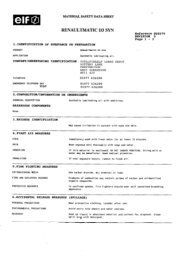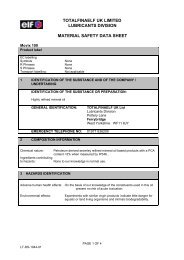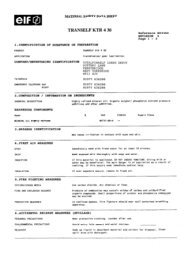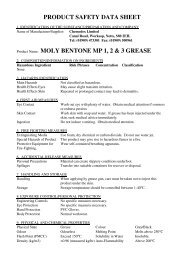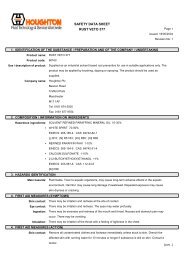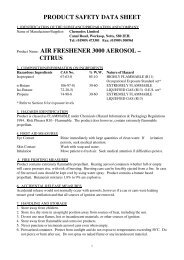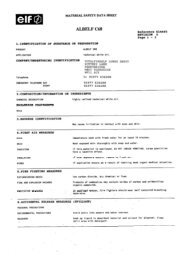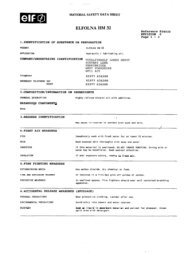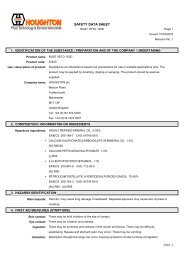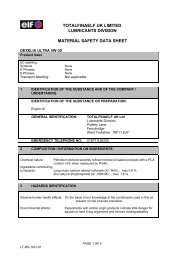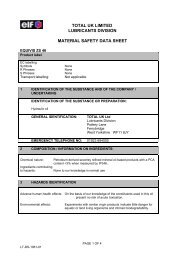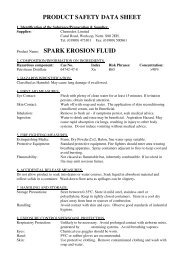Aero 80 LT-DS-648-01.pdf - CHEMODEX Ltd
Aero 80 LT-DS-648-01.pdf - CHEMODEX Ltd
Aero 80 LT-DS-648-01.pdf - CHEMODEX Ltd
- No tags were found...
Create successful ePaper yourself
Turn your PDF publications into a flip-book with our unique Google optimized e-Paper software.
TOTAL UK LIMITEDLUBRICANTS DIVISIONMATERIAL SAFETY DATA SHEETAERO <strong>80</strong>Product labelEC labellingSymbolsR PhrasesS PhrasesTransport labelling:NoneNoneNoneNot applicable1 IDENTIFICATION OF THE SUBSTANCE AND OF THE COMPANY /UNDERTAKINGIDENTIFICATION OF THE SUBSTANCE OR PREPARATION:Aircraft engine oilGENERAL IDENTIFICATION:TOTAL UK <strong>Ltd</strong>Lubricants DivisionPottery LaneFerrybridgeWest Yorkshire WF11 8JYEMERGENCY TELEPHONE NO: 01977 6362002 COMPOSITION / INFORMATION ON INGREDIENTS:Chemical nature:Subtances contributing to hazards :Petroleum-derived severely refined mineral-base productContent in PAH according to IP 346 method < 3%None to our knowledge under normal conditions of use3 HAZAR<strong>DS</strong> IDENTIFICATION- Adverse human health effects : Under normal conditions of use, the product holds nodanger of intoxication- Environmental effects : Don't rejet this product into the environment- physical and chemical hazards : No specific risk of fire or explosion under normal contitionsof use<strong>LT</strong>-<strong>DS</strong>-<strong>648</strong>-01PAGE 1 OF 5
4 FIRST AID MEASURESInhalation :Inhalation of heavy concentrations of vapour, fumes or spray, may causemild irritation of the throat.Transport the person into fresh air, keep warm and allow to restContact with the skin : Immediately remove all soiled or stained clothingWash the affected area immediately and repeatedly with soap and water.If the skin is exposed to high-pressure spray, the product may enter thehuman organism. In all such cases the affected person must be taken tohospital, even if no sign of injury can be detectedContact with the eyes : Keep eyes open and rinse immediately and repeatedly with water for atleast 15 minutesIngestion :Possible risk of vomiting and diarrhoeaDo not induce vomiting to avoid the risk of aspiration into the respiratorytractGive nothing to drinkAspiration :If the product is believed to have entered the lungs (in case of vomiting, forexample), take the person to hospital for immediate care.5 FIRE-FIGHTING MEASURESExtinguish with dry powder, foam, sand or earth. For small fires use CO2.Do not tackle fires with water. Water may be used to cool the area surrounding fires.Fires in closed or confined spaces should be tackled by trained personnel who should wearbreathing apparatus.6 ACCIDENTAL RELEASE MEASURESMay cause slippery surfaces. Wear appropriate hydrocarbon proof clothing, goggles, gloves andboots.Contain spillage – take all necessary precautions to prevent water and ground pollution. Do notwash spillage down drain. Report any escape to public drainage or watercourses to Local Authorityand Fire Brigade.Use mechanical means such as pumps or skimmers. Absorb using absorbent clay, sand or othersuitable absorbent. Dispose of waste and contaminated material through and authorised wastecollector.7 HANDLING AND STORAGEHANDLINGTechnical measures :of<strong>LT</strong>-<strong>DS</strong>-<strong>648</strong>-01prevention of user exposure Provide adequate ventilation in casethe potential formation of vapour, fumes, mist or sprayTake all measures to reduce the risk of exposure, in particular toused or waste productKeep away from flammable material; keep away from food andbeveragesPrevention of fire and explosion : Empty containers may contain flammable or explosive vapoursThere is a fire hazard associated with rags, paper or any othermaterial used to remove spills which become soaked with productAvoid accumulate of these: they are to be disposed off safely afterusePrecautions :Safe handling advice :Avoid static electricity build up with connection to earth.Set up machinery and equipment so as to avoid the risk ofaccidental spills or splashes onto hot machine parts and electricalcontacts (on joint failure, for example)Avoid contact with strong oxidizers.Use only hydrocarbon-resistant containers, joints, pipes etc...PAGE 2 OF 5
STORAGETechnical measures :Storage conditions :To be avoided :Incompatible products :Packaging materials :Make the necessary arrangements and take all measures toprevent water and ground pollutionSuitable Store at room temperature, protected against contact withwater and moisture, and away from any source of ignitionKeep containers closed when not in useDo not store exposed to the elementsDangerous reaction with strong oxidizing agentsRecommended Use only hydrocarbon-resistant containers, joints,pipes, etc.Keep in original container if possible8 EXPOSURE CONTROL / PERSONAL PROTECTIONAs with all products keep skin contact to a minimum and ensure good hygiene standards.Respiratory protection :Long term exposure limit :Short term exposure limit :Unlikely to be required in normal use. Note occupational exposurelimits for Oil Mist (HSE Guidance Note EH 40/Latest Issue).5 milligrams per cubic metre for 8 hours.10 milligrams per cubic metre for 15 minutes.Hand and skin protection - If contained or repeated exposure is likely PROTECTIVE CLOTHINGSHOULD BE WORN including gloves (hydrocarbon proof).Eye protection - Eye protection should be worn if splashing is likely.9 PHYSICAL AND CHEMICAL PROPERTIESAppearance:- Physical state: Liquid- Colour: Yellow to amber.Odour:CharacteristicpH:Not applicableSpecific temperaturesof change in state- Flow point: Not applicableFlash point: >= 240°C (ASTM D 92)Auto-ignition temperature: > 250°C (ASTM E 659)This temperature may be significantly lower under particular conditions (oxidation on high surfaceareas)Explosion limits:Not applicableDensity: About 891kg/m3 at 15°CSolubility:- in water: Insoluble and immiscible.- in organic solvents: Soluble in many common solvents- Viscosity: Kinematic viscosity at 100 °C : approx 15.2 mm²/s.Log P n-octanol / water at 20°C mineral oil > 610 STABILITY AND REACTIVITYStability :The product is stable under normal temperatures ofstorage, handling and use.Conditions to Avoid :Heat, sparks, ignition points, flames, static electricity etc.Materials to Avoid :Strong oxidising materials.Hazardous Decomposition Products : Oxides of carbon (CO 2 , CO), various hydrocarbons,aldehydes and soot. Hydrolysis in water produces phenol.11 TOXICOLOGICAL INFORMATION<strong>LT</strong>-<strong>DS</strong>-<strong>648</strong>-01PAGE 3 OF 5
Acute toxicity/local effects:-Inhalation:Risk is improbable under normal conditions of use.Strong concentrations of vapour and spray may be irritating torespiratory tract and mucous membranes-Contact with skin: Risk is improbable under normal conditions of use-Ingestion:Risk is improbable under normal conditions of use, ingestion of largeamounts may cause abdominal pain, diarrhoea etc.Sensitisation:-Contact with skin: To our knowledge the product does not induce sensitisation.Chronic toxicity or long term toxicity:-Inhalation:Vapour and spray may be irritate the respiratory tract and mucousmembranes.-Contact with skin: Characteristic skin infections (oil blisters) may develop followingprolonged and repeated exposure through contact with contaminatedclothing.12 ECOLOGICAL INFORMATIONMobility:- Air: there is a slow loss by evaporation.- Ground: Given its physical and chemical characteristics, the productgenerally shows little mobility in the ground- Water: The product is insoluble; it spreads on the surface of the waterPersistence and degradability: Experimental data on the finished product are not availableHowever, the "mineral oil" portion of the virgin product isintrinsically biodegradableParticular ingredients may not be biodegradableEcotoxicity:The virgin product is considered to present no danger for landgrowingorganisms.It is considered to present a little danger for aquatic life.No information available for used product13 DISPOSAL CONSIDERATIONSDisposal - by incineration or by methods approved by Local Authority.14 TRANSPORT INFORMATIONUN NumberRoad (ADR) / Rail (RID)Marine (IMO-IMDG)Air transport (ICAO / IATA)OtherunregulatedNot restricted for transport.Not restricted for transport.Not restricted for transport.Not classified as dangerous substances according totransportation rules15 REGULATORY INFORMATIONEUROPEAN REGULATIONS* EC labeling :- Symbol(s) None- R Phrase(s) None- S Phrase(s) None<strong>LT</strong>-<strong>DS</strong>-<strong>648</strong>-01PAGE 4 OF 5
16 OTHER INFORMATIONWhen used, oil becomes contaminated. Avoid prolonged and repeated skin contact and washimmediately after such contact.Further Information can be found in Health and Safety Executive Publications a list of whichmay be made available on request.Do not dispose of used engine oil in drains, soil or waterLiabilityThe information contained in this data sheet is accurate to the best of TOTALFINA GREAT BRITAIN Limited's knowledge. It applies only to the products designated hereinand supplied by TOTALFINA GREAT BRITAIN Limited or it's subsidiaries. The customer is strongly advised to observe and ensure that it's employees and customersobserve all directions contained herein, however neither TOTALFINA GREAT BRITAIN Limited, nor any of it's subsidiary companies accepts any liability whatsoever (otherthan liability in respect of matters referred to in Section 2 Unfair Contract Terms Act 1977 and in Section 7 Consumer Protection Act 1987) arising out of the use of theinformation or the use adaptation or processing of the products designated herein.Where third party products are used in conjunction with or instead of products produced or supplied by TOTALFINA GREAT BRITAIN Limited or its subsidiary companies, thecustomer should himself obtain all necessary technical, health and safety information about such products from the third party.<strong>LT</strong>-<strong>DS</strong>-<strong>648</strong>-01PAGE 5 OF 5



